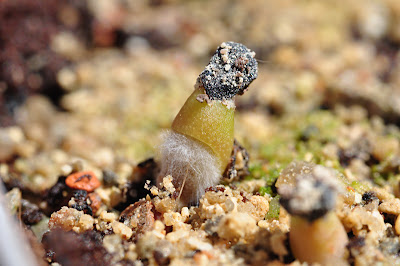
Immaculate Echinocactus polycephalus seedling
Back in 2009 I bought 100 seeds each of Echinocactus polycephalus (SNL 91; Las Vegas, Nevada) and Echinocactus horizonthalonius (SB 409; Shafter, Texas) from Mesa Garden. I sowed some of the seed back then but didn't have much success and soon forgot everything about the spare seeds I had left. That is until a few days ago :-)
As the seeds, in my (limited) experience, are extremely hard to germinate I decided to scarify them with a scalpel. You have to be very careful not to damage the embryo when making shallow cuts in the testa (seed coat) with a scalpel - and manually scarifying 80-some tiny seeds is an extreme test of your patience. After brutally cleaving several seed embryos I settled for chipping away at the protrusion of the hilum - this allowed me to break of small pieces of the testa without damaging the embryo within. The scarified seeds were left to soak in water for a few hours - I added the smallest tad of detergent to remove the water surface tension and allow for more efficient soaking of the seeds.

Echinocactus polycephalus seedling in the process of damping off - killed by mold
A few days after sowing the seeds several seedlings have surfaced. Unfortunately a few of them are already showing "rusty" spots and some has completely damped off, killed by mold. Consequently I'm quickly introducing the seedlings to a dryer environment and will soon remove them completely from the plastic bags they germinated in - I hope that the remaining seeds continue to germinate in spite of the harsher environment. Steve Brack's encouraging notes regarding this type of cacti reads: "rot easily, right after germination: not too wet, dry air and stronger light."

Etiolated Echinocactus polycephalus seedling, red from the sun
Some of the seedlings seem to have a hard time ridding themselves of the spent seed coat. They grow slightly etiolated and don't develop much chlorophyl in the deep shade of the testa - consequently they turn all red when exposed to the sunlight.

Echinocactus polycephalus seedling showing "rusty" spots
As usual I'm germinating my seeds in pots placed in clear plastic bags. As it's early summer I'm experimenting with germinating the seeds outdoors on the balcony - the daytime temperatures are around 20 C (68 F) with pleasantly cool nights. The temperature inside the bags off course grow hotter as they are exposed to sun during the day.

Bags containing Echinocactus, Ariocarpus, Aztekium, and peyote seedlings
With time I hope that my seedlings grow to look like this beautiful cluster of Echinocactus polycephalus (var. xeranthemoides) that overlooks the Tonto Platform in the Grand Canyon

Echinocactus polycephalus (var. xeranthemoides) overlooking the Tonto Platform
The Echinocactus horizonthalonius seedlings seem somewhat easier and more "well behaved". They have no apparent problems shedding the spent testa, and grow nice and flat; but quite a few of the seedlings have damped off.

Echinocactus horizonthalonius seedling

Echinocactus horizonthalonius seedling ridding itself of the spent seed coat
It's probably not going to be in my lifetime, but I hope my seedlings will grow to look like the fine specimen featured at the Chrudimský Kaktusář web site:

Flowering Echinocactus horizonthalonius
Catálogo de las plantas vasculares del Cono Sur : v. 107(1) 2008 (added:
04/12/2024)
-
*By:*
Belgrano, Manuel J.
Instituto de Botánica Darwinion (San Isidro, Argentina)
Missouri Botanical Garden.
Morrone, Osvaldo.
Zuloaga, Fernando O.
*Publica...
6 days ago



















No comments:
Post a Comment